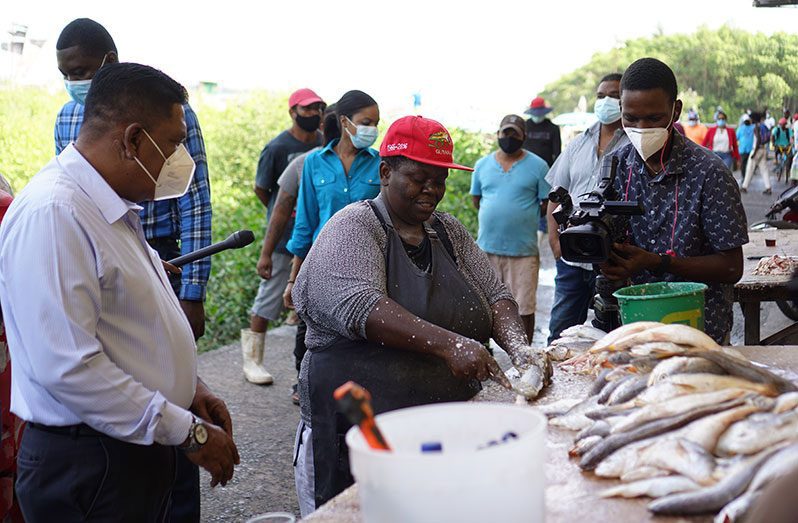DURING the first half of 2021, exports for the fisheries sector have surpassed $4 billion, according to figures provided by Minister of Agriculture, Zulfikar Mustapha. The figures indicated that during the first six months of the year, the fisheries industry netted some $27 million in revenue.
To further improve the sector’s earning capacity, the Ministry of Agriculture has embarked on a series of initiatives, including the reviewing and updating of the country’s Inland Fisheries and Aquaculture Strategy (2021-2026); the resuscitation of the National Fisherfolk Organisation; the development of a fishing vessel inspection programme; and, more importantly, the training of sector officials who can further train local fisherfolk.
Only recently, Minister Mustapha engaged the United States Economic Affairs Department to assist in addressing some of the challenges faced by the players within the local fishing industry, and to ensure its sustainability.
The Agriculture Minister had informed the government’s Department of Public Information that he had been tasked with identifying focal points that can be discussed at a more technical level with the US officials. “We will be meeting almost on a monthly or bi-monthly basis to deal with these issues. But these are very important trade issues for us,” Mustapha said.
RESILIENCE
Notwithstanding the myriad of challenges that have only been compounded by the advent of climate change, the fisheries sector continued its resilience.
As a matter of fact, last year, the fisheries sector managed to secure revenue in excess of $16 billion, while aquaculture mustered $207,251,016.
According to the Food and Agriculture Organisation of the United Nations (FAO), in Guyana, “capture fisheries” is undertaken by artisanal fishers and by an industrial fishing fleet composed of trawlers and hand-liners, including some foreign flagged, licensed vessels.
The organisation said most of Guyana’s fishing effort occurs in the relatively shallow waters of the continental shelf. In 2017, the estimated fleet comprised an estimated 1,498 vessels ranging in size from six to 24 metres, of which the great majority (83 per cent) were gill netters.
Aquaculture, on the other hand, has been practised for many years using mostly “low-input culture method” in brackish water and freshwater ponds, employing cachama, tilapia, and whiteleg shrimp as the major target species.
The consolidated contribution of both aspects of this industry accounted for two per cent of Guyana’s overall Gross Domestic Product (GDP) and 12 per cent of the agricultural GDP in 2020.
Information shared with the Guyana Chronicle shows that production in the area of marine fisheries was just over 30,000 metric tonnes at the end of November 2020, but was projected to end the year at over 35,000 metric tonnes. Total production was just above 38,000 metric tonnes in 2019.
Also, last year, Guyana produced finfish (artisanal), finfish (industrial), red snapper, prawns, seabob (industrial), whitebelly, seabob (artisanal) and tuna. Of those varieties, finfish raked over $11 billion — the most revenue for this industry — while red snapper and seabob each earned stakeholders over $1 billion.
Production, in the aquaculture sector, up to November last year was 121,741 kilograms, but was projected to end the year at 137, 626 kilograms. Total production was just above 246, 919 kilograms in 2019. This sub-sector produces bashaw, black shrimps, hassar, mullet, querriman, tambaqui and tilapia.
RELATIVELY SMALL
The aquaculture sector in Guyana is still relatively small, with production occupying only about 350 hectares of land around the country. But, it was reported recently that the government will be working towards making this sector globally competitive and a key contributor to economic growth, through several initiatives like the expansion of the Satyadeow Sawh Aquaculture Station and aquaculture zoning, both on land and in water.
Aquaculture, a component of the agriculture sector, is the process of rearing, breeding and harvesting of aquatic species, both animals and plants, in controlled aquatic environments like the oceans, lakes, rivers, ponds and streams.
“Aquaculture in Guyana shows strong potential since the country has relatively large acres of flat lands with suitable soil types and access to large quantities and good quality freshwater (water conservancies)… moreso there are existing drainage and irrigation infrastructure in some areas, sub-tropical temperatures for shrimp and fish production and good availability of agricultural/ fisheries by-products for the formulation and manufacturing of aqua feed,” Minister Mustapha said in a recent report.
The FAO has already provided US$100,000 to Guyana in 2019, to strengthen the strategic and regulatory framework for inland fisheries and aquaculture development in Guyana.
The fisheries department, in collaboration with the FAO, is expected to convert a draft aquaculture regulation to a legal document in 2021. Compliance with this regulation and the relevant authorities like the Environmental Protection Agency, Veterinary Public Health Unit and the Guyana Livestock Development Authority will be requirements for aquaculture operations.
Added to that, the government has allocated, in its 2021 budget, $293 million to develop the fisheries sector. This provision will be specifically directed towards facilitating feed-formulation research with the aim of reducing the cost of feed to below $200 per kilogramme, thereby encouraging increased investment and productivity.
Currently, the cost of production for aquaculture products is greatly impacted by the cost of feed, which accounts for some 60-70 per cent of overall production costs.
As it is, the fishing industry employs some 8,400 people in harvesting and 5,000 in processing and marketing, so more than 10,000 livelihoods depend directly on fishery, and many more benefit indirectly from fishing-related occupations such as boat building, gear supply and repair.
According to the FAO, a significant number of persons work in processing, distributing and selling fish and fish products in domestic markets. A high proportion of workers in processing, distribution and retail are women, and they are active in harvesting as well.



.png)









